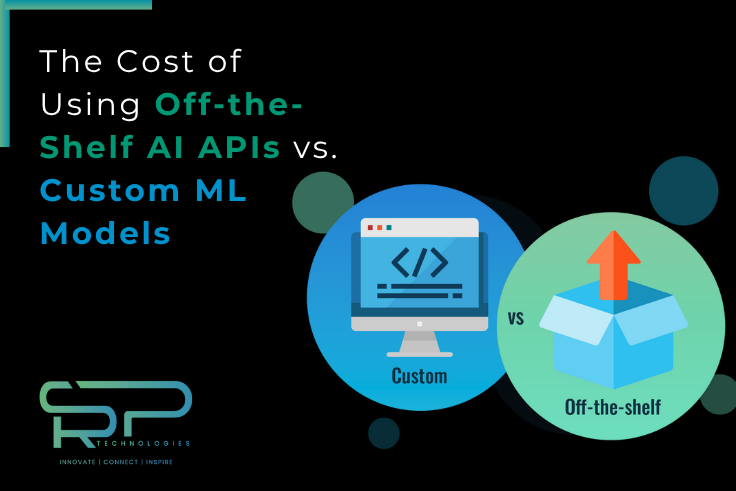
The Cost of Using Off-the-Shelf AI APIs vs. Custom ML Models

The Cost of Using Off-the-Shelf AI APIs vs. Custom ML Models
In today’s AI-driven world, businesses are often faced with a strategic decision: Should they adopt off-the-shelf AI APIs or invest in building custom ML models tailored to their unique needs? Understanding the cost implications of both paths is essential, especially as AI becomes central to product development, customer experience, and operational efficiency.
Let’s break down the cost, performance, and long-term value differences between these two options to help you make an informed decision.
Understanding Off-the-Shelf AI APIs
Off-the-shelf AI APIs are pre-built solutions offered by tech giants like Google, Amazon, Microsoft, and OpenAI. These APIs often include functionalities such as:
-
Image recognition
-
Natural language processing
-
Speech-to-text and text-to-speech
-
Chatbots and language models
-
Sentiment analysis
They are easy to integrate, require minimal setup, and allow developers to leverage advanced AI tools without having deep expertise in machine learning.
Understanding Custom ML Models
Custom ML models are built from the ground up to serve a specific business purpose. This involves:
-
Gathering and cleaning proprietary data
-
Selecting or designing algorithms
-
Training and validating the model
-
Deploying and monitoring in production
-
Regular updates and retraining
Custom ML models offer unmatched control, adaptability, and accuracy, especially when dealing with niche or proprietary data.
Cost Comparison: Off-the-Shelf vs. Custom ML Models
1. Upfront Costs
Off-the-Shelf AI APIs:
-
No upfront development cost.
-
You pay as you use — typically based on number of requests or volume of data processed.
Custom ML Models:
-
Significant upfront investment in terms of time, resources, and infrastructure.
-
You need data scientists, ML engineers, and potentially a DevOps team.
➡ Verdict: Off-the-shelf APIs are cheaper to start with, while custom ML models require a budget allocation early on.
2. Scalability and Usage Costs
Off-the-Shelf AI APIs:
-
Costs increase linearly with usage.
-
For high-volume applications, costs can become substantial over time.
Custom ML Models:
-
After deployment, running your model in your environment (e.g., on cloud VMs) can be significantly cheaper.
-
You control resource usage, scaling, and performance optimizations.
➡ Verdict: For small-scale or infrequent usage, APIs are more economical. For high-scale deployments, custom ML models win in cost-efficiency long-term.
3. Customization and Accuracy
Off-the-Shelf AI APIs:
-
Generalized performance.
-
May not perform well on domain-specific tasks or languages.
-
Limited ability to fine-tune.
Custom ML Models:
-
Can be trained on your business’s exact data.
-
Higher precision, recall, and performance in specialized use-cases.
-
Fully customizable and adaptable over time.
➡ Verdict: If your business requires precision and domain-specific intelligence, custom ML models are essential.
4. Maintenance and Updates
Off-the-Shelf AI APIs:
-
Maintained and updated by the provider.
-
No effort required from your team.
-
Risk of changes or discontinuation without notice.
Custom ML Models:
-
Maintenance, retraining, and updating are your responsibility.
-
Requires a dedicated ML operations strategy.
➡ Verdict: Off-the-shelf options minimize maintenance burden. However, for businesses with internal tech capabilities, custom ML models provide more control.
5. Data Privacy and Security
Off-the-Shelf AI APIs:
-
Data is sent to third-party servers.
-
Potential compliance concerns depending on industry (e.g., healthcare, finance).
Custom ML Models:
-
Data stays within your infrastructure.
-
Full control over compliance, encryption, and audit logging.
➡ Verdict: Custom ML models offer superior privacy and data governance.
When to Choose Off-the-Shelf AI APIs
-
Budget is limited
-
Quick deployment is a priority
-
Use-cases are generic (e.g., sentiment analysis, language translation)
-
No access to specialized ML talent
When to Choose Custom ML Models
-
You handle large volumes of domain-specific data
-
You require high accuracy and business-specific insights
-
You want long-term cost control
-
Regulatory compliance and data privacy are crucial
Hybrid Approach: The Best of Both Worlds
Many companies use a hybrid approach starting with off-the-shelf APIs for prototyping and then gradually transitioning to custom ML models as their needs grow. This allows you to validate ideas, gather data, and build internal AI capabilities at a manageable pace.
Final Thoughts
While off-the-shelf AI APIs offer convenience and speed, they come with limitations in cost scalability, accuracy, and data privacy. On the other hand, custom ML models require a higher upfront investment but offer long-term control, performance, and flexibility.
Choosing between the two depends on your business’s size, technical maturity, and specific needs. In many cases, a phased strategy — starting with APIs and transitioning to custom ML models strikes the right balance between cost and capability.
If you’re unsure which route to take, SRP Technologies can help you assess, plan, and implement the right AI strategy whether that means integrating existing APIs or building custom ML models from scratch.

